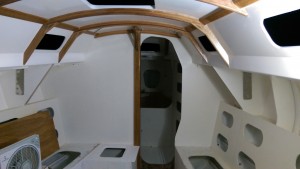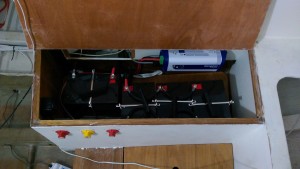
The instrument panel with 12 volt panel, chartplotter, VHF and AM/FM radio. On the right is the tank level. 12 volt outlet and 240 volt panel.
It has been over three weeks since my last progress report on the building or our Didi 40 Cr due to a break from building when we drove to Adelaide for the Laser Nationals. Prior to the break I was busy painting all the galley components and working on the ice box. Since we returned home on Friday 6th it has been a frantic effort to keep the painting ahead of the electrical installation.
I have been drilling lots of cable holes and openings for instruments and mounting them ahead of my boat electrician schedule. From Monday to Friday he completed a substantial amount of the wiring and we now have the engine battery and three house batteries installed and on charge from the shore power battery charger. The 12 volt panel is wired up and power has been supplied to the two chart plotters and to the autopilot. We are waiting for some Seatalkng connectors to connect the power to the backbone and light up the water speed, wind speed and autopilot control instruments. We are also waiting on a long networking cable to send data between the two chart plotters and a cable to convert Sealtalkng to NMEA 2000 to interface with the AIS.
Most of the light fittings have been mounted but removed so I can finish the top coat.
The other change has been the painting of the bulkheads white instead of the planned clear finish. I was planning on just a couple of coats of varnish over the epoxy on the bulkheads to save time but the first coat of varnish showed up too many imperfections in the timber so I have gone for an extra two coats of undercoat and a top coat or two. The warm weather has helped the paint drying process but it is best to leave each coat for two days for ideal sanding conditions. This week I plan to install the plumbing and fit in the last of the major painting in between. I also have to mount a number of 12 mm ply panels for securing electrical equipment to the hull as we cannot drill into the single 12 mm skin. There is also a 24 mm thick panel required to bring the skin up to 36 mm for the base of the autopilot actuator. I will get a stainless steel backing plate for this as the bolts will go through the transom and will need to be decorative as well as functional.
Our stainless steel pulpit and pushpits have been trial mounted and I am just waiting for help to finish the fixing to the hull. I did a shop on the super hot Wednesday last week for the autopilot and second chart plotter and on Saturday another shop for more paint and all the nuts and bolts for fixing the rest of the fittings.

